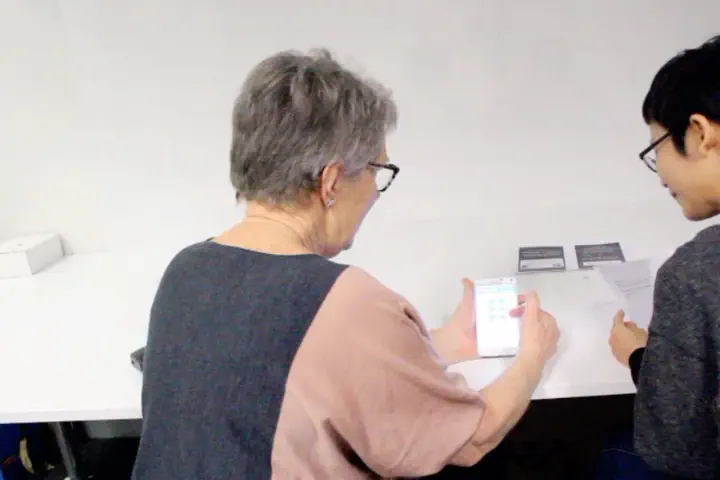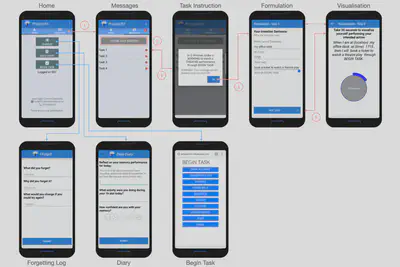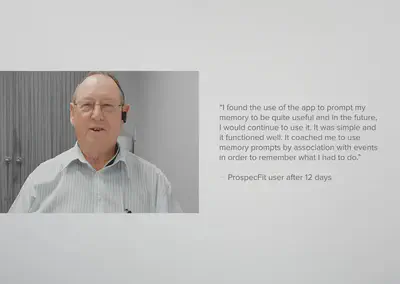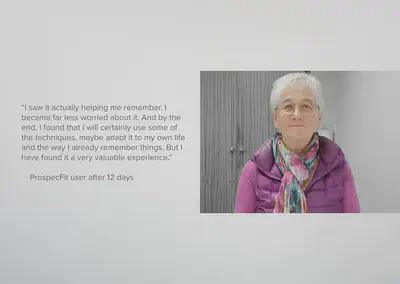
The ProspecFit project aimed to provide memory training by facilitating an effective memory technique and making it available on smartphones through iterative design.
Table of Contents
Overview
Prospective memory lapses are the most common form of memory lapses faced (72%). They involve forgetting to perform intended actions such as taking medication after a meal. Memory training can help tackle them. ProspecFit uses a memory technique, called “when-then technique” or implementation intentions, which has been effective at improving prospective memory but is typically taught verbally and in lab settings.
The project draws insights from a focus group and preliminary studies. ProspecFit has been evaluated with 10 adults (61 to 80 years old) through 12-day in situ testing as well as pre- and post-testing to test the effectiveness of the digital memory training. View the video below for more details.
Role
I led this research:
- Concept development
- Developed ProspecFit’s Android application
- Designed and conducted focus group, usability testing and evaluation studies
Assistance in development: Adrian Robertson, Thisum Buddhika and Vipula Dissanayake Assistance in think-aloud testing: Yvonne Chua and Haimo Zhang
Process
Focus Group
To start off the project, I first wanted to understand my target users, older adults, and gain insights into the types of memory lapses faced, strategies used to tackle them and reasons behind memory lapses. I conducted a focus group with 8 older adults.
Key Findings:
- Out of the types of memory lapses faced in everyday life (attention, episodic, prospective and semantic), they most frequently faced prospective memory lapses.
- Writing to-do lists, using calendars and reminders were among the commonly-used solutions. A few mentioned memory training methods such as doing crossword puzzles and Sudoku.
- The use of Lumosity, a memory training app, by one participant sparked interest in other participants to try it for themselves. Their interest was because the app gave daily brain exercises, they saw it as a way to keep their brains active, and most of them had smartphones to use the app.
Despite current solutions, the issue of prospective memory lapses persists and commonly-used solutions only support memory but may not enhance or maintain memory functions.
Memory training apps and methods have been used to fill this gap and keep the mind active. However, the cognitive exercises and games presented in many memory training methods are abstract and may be hard for users to apply their learning to their own daily tasks.
Development of ProspecFit Application
Concept and Memory Technique
The idea was to provide memory training by guiding users on how to apply a memory technique to naturalistic tasks (daily life tasks).
The “when-then technique” or implementation intentions is a known memory method for strengthening prospective memory. It has two main steps:
- Formulating an intention sentence. Example: “When I leave home at noon on Wednesday, then I will bring Matt’s gift.”
- Visualise yourself encountering the situation cues (Example: the door of your home, a clock that shows noon) and then performing your intended action (Example: picking up the gift and placing it in your bag).
The four images below show screenshots of the instructions given to users to explain the technique.
Mock-Ups
I designed mock-ups and wireframe sketches of an application that would guide users to apply the technique. The video below shows a walkthrough of the initial mock-up.
Implementation
The app was implemented on Android using Android Studio (Java). User responses and usage details were stored and retrieved by the app via Firebase database.

Figure 1 shows the user flow and screenshots of the ProspecFit app.
To facilitate the memory training:
- Users start out at the Home screen and could select the Messages tab
- When they choose to start a 1h training slot, they will receive 4 memory tasks.
- After choosing a task, the task instructions are shown.
- Upon confirmation of the task instruction, users are led to the first step of the memory technique, Formulation, where they fill in situation cues in an intention sentence.
- In the next step, Visualisation, they are instructed to visualise performing the intended action and could start a timer that rings after 30 seconds (recommended time for visualisation according to previous work).
Other than facilitating the memory technique, the app also lets users spontaneously record forgetful moments (Forgetting Log), reflect on their memory and confidence in their memory in a digital Diary and link to a web application where they can complete their memory tasks (Begin Task). These features were included to help with conducting the 12-day in-situ study.
Results
Details on the design process, user studies and implementation for ProspecFit have been published in a paper in IMWUT 2019 (see paper below).
In our 12-day, in-situ and between-group study (Group 1: Treatment - with digital memory training and Group 2: Control - without digital memory training), we showed that:
- The digital memory training group were significantly more prompt (more on-time) at completing their memory tasks than the control group.
- The digital memory training group also reported improvement in their prospective memory.
Feedback from two users are portrayed in the images below (alternative text available).

